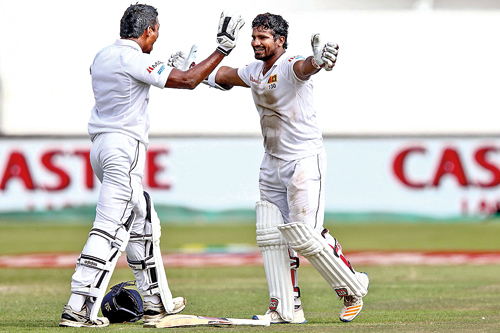Former top players oppose 4-day Test

Epic Test finishes have occurred on the fifth and final day
There were just two balls of the match remaining when paceman Shaminda Eranga banged in a short ball to Jimmy Anderson and it ballooned from his glove to Rangana Herath parked on the leg side, scripting a historic win in 2014. Sri Lanka won in a dramatic fashion, thereby registering their first series victory against England in their own den.
This would not have happened if Test cricket was played over four-days, a proposal the game’s global keeper, International Cricket Council (ICC), is now seriously considering as a means to tackling a crowded international calendar, reducing costs and maximizing broadcast revenue as new generations of fans increasingly move away from the longer format.
It may be that fewer matches have lasted the full five days. But take some of the greatest games in history and all have gone down to the wire. Kusal Perera’s epic 153 against South Africa, one of the most memorable cricket knocks, happened on the fifth day. Even England’s hard-fought victory against South Africa the other week bears testimony to the importance of preserving the game’s purest form.
But commercials prerogatives are overtaking a game which once treasured its traditions more than money. Plans to cut Test matches from five to four days in the cycle starting 2023 will be discussed and debated by ICC’s Cricket Committee in March. Many purists, including Sri Lanka’s Rangana Herath–the highest Test wicket-taking left-arm bowler in the history of the game–wants to keep back the identity and beauty of the grueling format.
“It’s the ultimate test of a cricketer’s character,” said Herath, who retired from international cricket in 2018, having taken 433 wickets in 93 Test matches. “It should remain as it is. It tests a player mentally, physically, technically and tactically, like no other format. Any changes will only take that beauty away from the game.
This was echoed by other international cricketers who have come to the defence of the five-day format. Indian skipper Virat Kohli has openly criticised the move saying he does not endorse it. So, too, has the Federation of International Cricket Associations (FICA) which remarked: “There is currently lot of negative sentiment within the global collective of players towards such a significant change to the game’s most traditional format.”
Two former Sri Lanka greats, Mahela Jayawardena (a member of the ICC Cricket Committee that makes these recommendations) and Sanath Jayasuriya as well as a former Sri Lanka cap-turned-renowned-commentator, Russell Arnold, too, are against the proposal.
Jayawardena, in his official capacity, will debate the issue at the committee stage to support his personal view of playing Test cricket over five days while Jayasuriya, a legend in his own right, insisted the uniqueness of Test cricket should be protected.
“My personal view is that it should remain five days,” said Jayawardena, who started coaching since retiring. “I would not want any change.” Jayasuriya was more critical. He is known as a devastating hitter in world cricket, having played a pivotal role in Sri Lanka’s World Cup victory in 1996. But he is a fan of the longer format, although is approach to any format has been the same.
“Four-day cricket! No way,” he said. “Test cricket is the ultimate test of character and it should not be altered. Now we prepare wickets for five days. At times, matches finish inside four days. That doesn’t mean all the matches end in four days. As a cricketer, I loved the different challenges each day or each session offered and that is the beauty of Test cricket. So please leave Test cricket alone.”
Arnold aired similar sentiments. “I still prefer five-day Tests,” he reflected. “That allows players to be challenged fully and conditions to evolve. Many of the best Test matches of late have given us results on the fifth day.” Arnold admitted that Test cricket is under threat with the new innovations being proposed.
“There is a threat to expanding the game,” he acknowledged. “Life has evolved and there are time constraints on people with busy schedules. So the shorter form is winning but it is also coupled with entertainment components and a deep knowledge of the game is not required to enjoy it. Those who know the game deeply are the ones who enjoy Test cricket and, nowadays, it’s a challenge to educate people.”
Herath and Jayasuriya believe four-day Tests would make draws more likely, encourage negative tactics and be a huge disadvantage to the spin bowlers.
“On a good sporting track, the ball will start to spin on the fourth and fifth day of a Test match,” Herath said. “With a possible early start to the day, seam bowlers are at a huge advantage with moisture on the pitch, etc, while spinners will find hard to take wickets. I think these are some of the issues the ICC should seriously look at before stamping on any changes to the format.
Jayasuriya, who has taken 98 Test and 323 ODI wickets with his left arm spins, agreed. “Teams will employ negative tactics, making Test cricket more boring to watch and this will take the fan further away from the longer format,” he concluded.
Four-day Tests were discussed earlier and the ICC tried them out in a 2017 game featuring Zimbabwe and South Africa. More lately, in July last year, England beat minnows Ireland inside three days in a four-day match. Additionally, the ICC also introduced day/night Tests to increase viewership and maximize profits.


